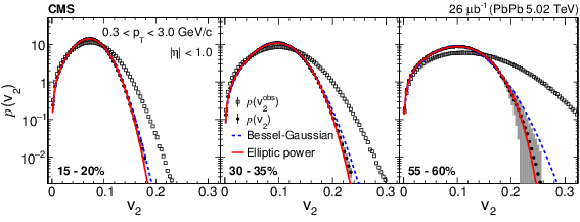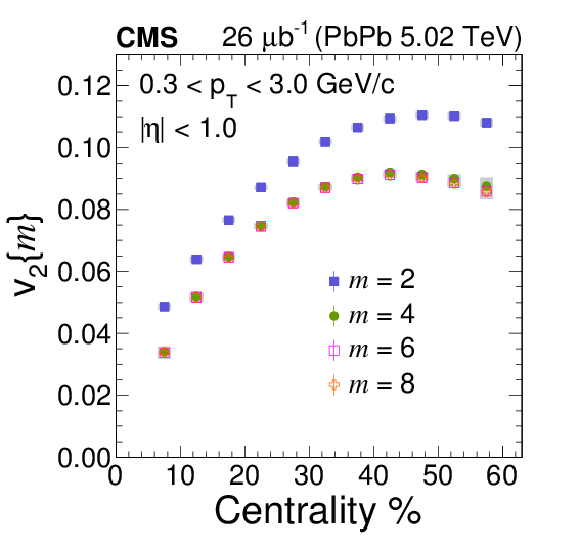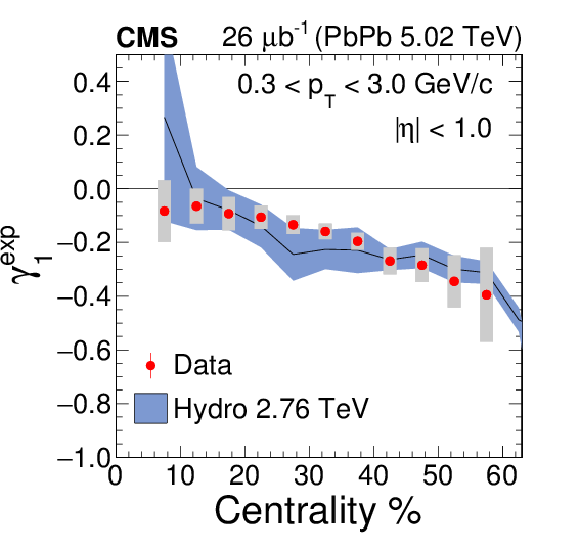

Compact Muon Solenoid
LHC, CERN
| CMS-HIN-16-019 ; CERN-EP-2017-268 | ||
| Non-Gaussian elliptic-flow fluctuations in PbPb collisions at $\sqrt{\smash[b]{s_{_\mathrm{NN}}}} = $ 5.02 TeV | ||
| CMS Collaboration | ||
| 15 November 2017 | ||
| Phys. Lett. B 789 (2019) 643 | ||
| Abstract: Event-by-event fluctuations in the elliptic-flow coefficient $v_2$ are studied in PbPb collisions at $\sqrt{\smash[b]{s_{_\mathrm{NN}}}} = $ 5.02 TeV using the CMS detector at the CERN LHC. Elliptic-flow probability distributions ${p}(v_2)$ for charged particles with transverse momentum 0.3 $ < {p_{\mathrm{T}}} < $ 3.0 GeV/$c$ and pseudorapidity $ | \eta | < $ 1.0 are determined for different collision centrality classes. The moments of the ${p}(v_2)$ distributions are used to calculate the $v_{2}$ coefficients based on cumulant orders 2, 4, 6, and 8. A rank ordering of the higher-order cumulant results and nonzero standardized skewness values obtained for the ${p}(v_2)$ distributions indicate non-Gaussian initial-state fluctuation behavior. Bessel-Gaussian and elliptic power fits to the flow distributions are studied to characterize the initial-state spatial anisotropy. | ||
| Links: e-print arXiv:1711.05594 [nucl-ex] (PDF) ; CDS record ; inSPIRE record ; HepData record ; CADI line (restricted) ; | ||
| Figures | |

png pdf |
Figure 1:
Representative final unfolded $p(v_2)$ distributions (closed black circles) in three centrality bins (15-20%, 30-35%, and 55-60%) obtained using D'Agostini iteration unfolding. Respective observed $p(v_2^\mathrm {obs})$ distributions (open black squares) are shown to illustrate the statistical resolution present in each centrality bin prior to unfolding. Systematic uncertainties from the unfolding procedure are presented as shaded bands. Distributions are fitted with Bessel-Gaussian (dashed blue lines) and elliptic power (solid red lines) functions to infer information on the underlying $p(\varepsilon _2)$ distributions. |

png pdf |
Figure 2:
Elliptic-flow cumulant harmonics with values obtained from the moments of the unfolded $p(v_2)$ distributions. Statistical uncertainties are smaller than the symbol size. Systematic uncertainties are shown as gray bands. |

png pdf |
Figure 3:
Ratios of higher order cumulant elliptic-flow harmonics with values obtained from the moments of the unfolded $p(v_2)$ distributions. Both statistical (lines) and systematic (gray bands) uncertainties are shown. Hydrodynamic predictions for 2.76 TeV collisions from Ref. [27] are presented as a dark color band and are compared to the measured $v_{2}\{6\}/v_2\{4\}$ ratio. In addition, higher order cumulant ratios reported by the ATLAS Collaboration for 2.76 TeV collisions [14] with 0.5 $ < {p_{\mathrm {T}}} < $ 20.0 GeV/$c$ and $ | \eta | < $ 2.5 are compared to the 5.02 TeV measurement. The error bars on the ATLAS measurement represent the quadratic sum of statistical and systematic uncertainties and points are offset horizontally for clarity. |

png pdf |
Figure 4:
The skewness estimate with respect to the reaction plane determined using the elliptic-flow harmonic based on different cumulant orders. Both statistical and systematic uncertainties are shown, where statistical uncertainties are smaller than the data points. Hydrodynamic model predictions for 2.76 TeV PbPb collisions from Ref. [27] are shown as a colored band. |

png pdf |
Figure 5:
Centrality dependence of the parameters extracted from elliptic power function fits to the unfolded $p(v_2)$ distributions. Both statistical (error bars) and systematic (shaded boxes) uncertainties are shown. The solid lines represent theoretical calculations from Ref. [11] using viscous hydrodynamics with Glauber initial conditions and an $\eta /s$ value of 0.19 to determine the response coefficient $k_2$. Glauber (blue shaded band) and IP-Glasma (red shaded band) model calculations from Ref. [11] are shown for the $\alpha $ and $\varepsilon _0$ parameters. |
| Summary |
|
In summary, a non-Gaussian behavior is observed in the event-by-event fluctuations of the elliptic flow $v_2$ coefficients in PbPb collisions recorded by the CMS detector at $\sqrt{\smash[b]{s_{_\mathrm{NN}}}} = $ 5.02 TeV. The probability distributions $p(v_2)$ for 5%-centrality bins between 5% and 60% centrality are found by unfolding statistical resolution effects from measured flow distributions. The $v_2$ coefficients corresponding to different cumulant orders are calculated from the moments of the unfolded $p(v_2)$ distributions. A rank ordering of $v_2\{4\} > v_2\{6\} > v_2\{8\}$, with differences on the order of a few percent, is observed for noncentral events with centralities greater than ${\approx}15%$. The standardized skewness of each $p(v_2)$ distribution is calculated using the cumulant results. In cases where there is a splitting of the cumulant values, the standardized skewness is found to be negative with an increasing magnitude as collisions become less central. Bessel-Gaussian and elliptic power functions are fitted to the unfolded $p(v_2)$ distributions. The two distributions are similar for central collisions, though the elliptic power function provides a better description for noncentral collisions. Based on the elliptic power function fits, the centrality dependence of the flow response coefficient, which relates the final state geometry to the initial state energy density distribution, is found to be consistent with model calculations. However, the observed eccentricities are smaller than predictions based on either the Glauber model or the IP-Glasma model initial conditions with an assumed linear flow response. The current results illustrate that LHC experiments now have the precision to explore the details of the initial-state fluctuation behavior. |
| References | ||||
| 1 | BRAHMS Collaboration | Quark-gluon plasma and color glass condensate at RHIC? The perspective from the BRAHMS experiment | NP A 757 (2005) 1 | nucl-ex/0410020 |
| 2 | PHENIX Collaboration | Formation of dense partonic matter in relativistic nucleus-nucleus collisions at RHIC: Experimental evaluation by the PHENIX Collaboration | NP A 757 (2005) 184 | nucl-ex/0410003 |
| 3 | B. B. Back et al. | The PHOBOS perspective on discoveries at RHIC | NP A 757 (2005) 28 | nucl-ex/0410022 |
| 4 | STAR Collaboration | Experimental and theoretical challenges in the search for the quark-gluon plasma: The STAR Collaboration's critical assessment of the evidence from RHIC collisions | NP A 757 (2005) 102 | nucl-ex/0501009 |
| 5 | ATLAS Collaboration | Observation of a centrality-dependent dijet asymmetry in lead-lead collisions at $ \sqrt{s_{_\text{NN}}}= $ 2.76 TeV with the ATLAS detector at the LHC | PRL 105 (2010) 252303 | 1011.6182 |
| 6 | CMS Collaboration | Observation and studies of jet quenching in PbPb collisions at $ \sqrt{s_{_\text{NN}}}= $ 2.76 TeV | PRC 84 (2011) 024906 | CMS-HIN-10-004 1102.1957 |
| 7 | U. Heinz, C. Shen, and H. Song | The viscosity of quark-gluon plasma at RHIC and the LHC | AIP Conf. Proc. 1441 (2012) 766 | 1108.5323 |
| 8 | G. Policastro, D. T. Son, and A. O. Starinets | Shear viscosity of strongly coupled $ N= $ 4 supersymmetric Yang-Mills plasma | PRL 87 (2001) 081601 | hep-th/0104066 |
| 9 | P. Kovtun, D. T. Son, and A. O. Starinets | Viscosity in Strongly Interacting Quantum Field Theories from Black Hole Physics | PRL 94 (2005) 111601 | hep-th/0405231 |
| 10 | L. Yan, J.-Y. Ollitrault, and A. M. Poskanzer | Eccentricity distributions in nucleus-nucleus collisions | PRC 90 (2014) 024903 | 1405.6595 |
| 11 | L. Yan, J.-Y. Ollitrault, and A. M. Poskanzer | Azimuthal anisotropy distributions in high-energy collisions | PLB 742 (2015) 290 | 1408.0921 |
| 12 | CMS Collaboration | Evidence for collective multiparticle correlations in p-Pb collisions | PRL 115 (2015) 012301 | CMS-HIN-14-006 1502.05382 |
| 13 | ALICE Collaboration | Multiparticle azimuthal correlations in p-Pb and Pb-Pb collisions at the CERN Large Hadron Collider | PRC 90 (2014) 054901 | 1406.2474 |
| 14 | ATLAS Collaboration | Measurement of flow harmonics with multi-particle cumulants in Pb+Pb collisions at $ \sqrt{s_{_\text{NN}}}= $ 2.76 TeV with the ATLAS detector | EPJC 74 (2014) 3157 | 1408.4342 |
| 15 | ATLAS Collaboration | Measurement of the distributions of event-by-event flow harmonics in lead-lead collisions at $ \sqrt{s_{_\text{NN}}}= $ 2.76 TeV with the ATLAS detector at the LHC | JHEP 11 (2013) 183 | 1305.2942 |
| 16 | J.-Y. Ollitrault | Anisotropy as a signature of transverse collective flow | PRD 46 (1992) 229 | |
| 17 | B. Alver and G. Roland | Collision-geometry fluctuations and triangular flow in heavy-ion collisions | PRC 81 (2010) 054905 | 1003.0194 |
| 18 | D. Teaney and L. Yan | Triangularity and dipole asymmetry in relativistic heavy ion collisions | PRC 83 (2011) 064904 | 1010.1876 |
| 19 | H. Song | QGP viscosity at RHIC and the LHC---a 2012 status report | NP A 904-905 (2013) 114c | 1210.5778 |
| 20 | Z. Qiu and U. W. Heinz | Event-by-event shape and flow fluctuations of relativistic heavy-ion collision fireballs | PRC 84 (2011) 024911 | 1104.0650 |
| 21 | S. A. Voloshin and A. M. Poskanzer | The physics of the centrality dependence of elliptic flow | PLB 474 (2000) 27 | nucl-th/9906075 |
| 22 | H.-J. Drescher, A. Dumitru, C. Gombeaud, and J.-Y. Ollitrault | Centrality dependence of elliptic flow, the hydrodynamic limit, and the viscosity of hot QCD | PRC 76 (2007) 024905 | 0704.3553 |
| 23 | N. Borghini, P. M. Dinh, and J.-Y. Ollitrault | New method for measuring azimuthal distributions in nucleus-nucleus collisions | PRC 63 (2001) 054906 | nucl-th/0007063 |
| 24 | N. Borghini, P. M. Dinh, and J.-Y. Ollitrault | Flow analysis from multiparticle azimuthal correlations | PRC 64 (2001) 054901 | nucl-th/0105040 |
| 25 | S. A. Voloshin, A. M. Poskanzer, A. Tang, and G. Wang | Elliptic flow in the Gaussian model of eccentricity fluctuations | PLB 659 (2008) 537 | 0708.0800 |
| 26 | J. Jia | Event-shape fluctuations and flow correlations in ultra-relativistic heavy-ion collisions | JPG 41 (2014) 124003 | 1407.6057 |
| 27 | G. Giacalone, L. Yan, J. Noronha-Hostler, and J.-Y. Ollitrault | Skewness of elliptic flow fluctuations | PRC 95 (2017) 014913 | 1608.01823 |
| 28 | S. Voloshin and Y. Zhang | Flow study in relativistic nuclear collisions by Fourier expansion of azimuthal particle distributions | Z. Phys. C 70 (1996) 665 | hep-ph/9407282 |
| 29 | CMS Collaboration | Description and performance of track and primary-vertex reconstruction with the CMS tracker | JINST 9 (2014) P10009 | CMS-TRK-11-001 1405.6569 |
| 30 | CMS Collaboration | The CMS experiment at the CERN LHC | JINST 3 (2008) S08004 | CMS-00-001 |
| 31 | CMS Collaboration | Charged-particle nuclear modification factors in PbPb and pPb collisions at $ \sqrt{s_{_\text{NN}}}= $ 5.02 TeV | JHEP 04 (2017) 039 | CMS-HIN-15-015 1611.01664 |
| 32 | A. M. Poskanzer and S. A. Voloshin | Methods for analyzing anisotropic flow in relativistic nuclear collisions | PRC 58 (1998) 1671 | nucl-ex/9805001 |
| 33 | J. Jia and S. Mohapatra | Disentangling flow and nonflow correlations via Bayesian unfolding of the event-by-event distributions of harmonic coefficients in ultrarelativistic heavy-ion collisions | PRC 88 (2013) 014907 | 1304.1471 |
| 34 | G. D'Agostini | A multidimensional unfolding method based on Bayes' theorem | NIMA 362 (1995) 487 | |
| 35 | W. H. Richardson | Bayesian-based iterative method of image restoration | J. Opt. Soc. Am. 62 (1972) 55 | |
| 36 | L. B. Lucy | An iterative technique for the rectification of observed distributions | Astron. J. 79 (1974) 745 | |
| 37 | T. Adye | Unfolding algorithms and tests using RooUnfold | in PHYSTAT 2011 Workshop on Statistical Issues Related to Discovery Claims in Search Experiments and Unfolding, H. Prosper and L. Lyons, eds., p. 313 Geneva, Switzerland | 1105.1160 |
| 38 | R. Brun and F. Rademakers | ROOT---An object oriented data analysis framework | NIMA 389 (1997) 81 | |
| 39 | M. L. Miller, K. Reygers, S. J. Sanders, and P. Steinberg | Glauber modeling in high energy nuclear collisions | Ann. Rev. Nucl. Part. Sci. 57 (2007) 205 | nucl-ex/0701025 |
| 40 | J. Noronha-Hostler, M. Luzum, and J.-Y. Ollitrault | Hydrodynamic predictions for 5.02 TeV Pb-Pb collisions | PRC 93 (2016) 034912 | 1511.06289 |
| 41 | B. Schenke, P. Tribedy, and R. Venugopalan | Event-by-event gluon multiplicity, energy density, and eccentricities in ultrarelativistic heavy-ion collisions | PRC 86 (2012) 034908 | 1206.6805 |
| 42 | B. Schenke, P. Tribedy, and R. Venugopalan | Gluon field fluctuations in nuclear collisions: Multiplicity and eccentricity distributions | NP A 926 (2014) 102 | 1312.5588 |

|
Compact Muon Solenoid LHC, CERN |

|

|

|

|

|

|